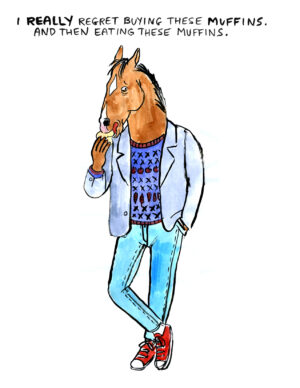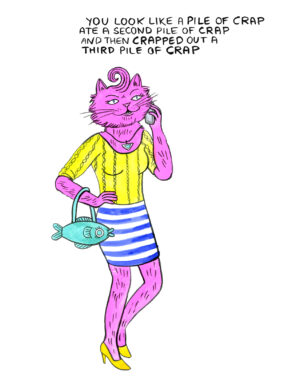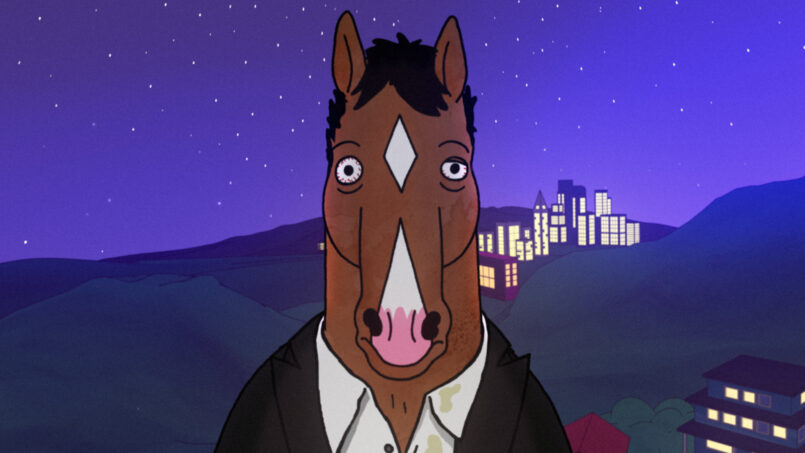In the finale of BoJack Horseman’s first season, BoJack—the star of beloved ’90s sitcom Horsin’ Around who has spent the last twenty-odd years hiding from the light of the real world in the shadow of the show’s legacy (also, he is a horse)—sits on his roof with his biographer, Diane Nguyen. Over the previous eleven episodes, BoJack has alienated everyone who cares for him, Diane included. “I just wanted you to like me,” he tells her. As the camera pans across Los Angeles, we see those he’s pushed away, each of them happily engaged in the business of giving and receiving love from other people. A Rolling Stones song plays, recasting a honky-tonk piano as an instrument of mourning. We come back to BoJack, who is now sitting on his couch alone, his blank stare illuminated by the glow of a TV showing reruns of Horsin’ Around. Your heart is so busy being broken that it takes a full sixty seconds to realize that the Rolling Stones song is “Wild Horses,” and that you’ve spent the last minute at the center of an elaborate joke.
“That was always the pitch from the beginning,” says Raphael Bob-Waksberg, the show’s creator. “We’re gonna trick people into having feelings.”
BoJack Horseman, whose second season on Netflix premiered this summer, would seem to be the next in a suddenly long line of offbeat animated series geared toward half-baked undergrads and insomniac Gen-Y-ers. In BoJack’s world, house cats can be Hollywood agents, Labrador retrievers can marry respected journalists, and naval seals can be Navy SEALs. E!-style celebrity dish shows are hosted by “A Ryan Seacrest Type” and “Some Lady.” It’s silly—high-grade, premium silly.
But that’s not all it is. “I’m not really interested in comedy for the sake of comedy,” Bob-Waksberg says. “I always want to know, ‘What’s this about? What are the characters going through?'” While the show’s first few episodes are sharp enough to give it an edge on its would-be peers in the animated world, the second half of the first season—and the entirety of the second—find Will Arnett‘s BoJack being pulled further into depression and narcissism as he wears his legacy like a leaden wreath. It’s earned the show—which, again, is about an animated horse and his talking-animal pals—comparisons to Mad Men and even some quiet “best show on TV” talk.
Executive producers Noel Bright and Steven A. Cohen were drawn to Bob-Waksberg’s vision from the beginning. When Cohen reels off the questions the show tackles, he almost sounds like he’s asking them himself: “[After you reach your goals,] what do you do with the rest of your life? How do you succeed? How do you become a better person? How do you get out of your own way?” Bob-Waksberg’s impeccable comedic sense notwithstanding, these ideas form the center of the show, with BoJack’s existential pacing outlining their answers in negative.
“[After you reach your goals,] what do you do with the rest of your life? How do you succeed? How do you become a better person? How do you get out of your own way?” — Executive producer Steven A. Cohen
To that end, nearly every aspect of BoJack Horseman is engineered to carry the twin weights of comedy and tragedy, from the factory farm owned by a sadistic family of chickens that shows up in season two (“No one knows chicken like chickens!”) to the fine-art parodies designer Lisa Hanawalt hangs on the characters’ walls (a Basquiat triptych in the office of Horsin’ Around creator Herb Kazzaz depicts the dissolution of his relationship with BoJack).
Hanawalt grew up with Bob-Waksberg, who attached several of her sketches to his initial pitch without her knowledge. “I’ve been drawing animal people my whole life,” Hanawalt says. “I recently looked back at some of my childhood artwork and I’ve been drawing horse and cat and dog people since I was six.” Her work on the show is informed by her art school background, and it goes beyond the occasional reference. Nearly every frame of BoJack Horseman is suffused with meaning. The animal characters tend to wear food-related clothing (“I think it’s really funny that if animals really did walk around and wear clothes like people, they’d wear clothes printed with the things that they like to eat most”) and her settings are dotted with personal artifacts; a café in one episode proudly displays a wall hanging from her parents’ house. While the precision of her line drawing grants the show’s characters a level of detail and personality, her specialty lies in the way they’re filled. BoJack’s watercolored mane, for instance, always seems to be stained. The skies—from the twilight purple of downtown LA to the kaleidoscopic New Mexico desert—seem strangely sympathetic, almost forgiving.
But the show’s most thematically complicated aesthetic choices might be the ones made around music, particularly the opening and closing theme songs, which are performed by The Black Keys‘ Patrick Carney and Grouplove, respectively. Carney’s opening theme is a chunky groove whose skipping backbeat sounds like it could have been lifted from The Black Keys’ Blakroc project. Carney warps the song’s throbbing center, zooming in and out on a bubble of a note as the title sequence shows BoJack blinking his way through an average day: waking below Warhol-esque prints of horseshoes, working on the set of the Secretariat biopic in which he’s starring, avoiding his friends and colleagues, and finally dropping off of his balcony and into his pool with bloodshot eyes. A blatty sax, courtesy of Carney’s Uncle Ralph, pops through the sequence like a flashbulb before finishing off with a series of stabs a few moments after BoJack hits the water.
“It’s a dark comedy and I think most of the music I end up making on my own is suitable for that kind of thing.” — Patrick Carney
“They were having a great time in the studio jamming out,” music supervisor Andy Gowan says of the piece. “And Patrick produced it and made a track around it.” Carney put the recording on the shelf, where it sat for a few years, until Gowan asked The Black Keys’ manager if the group would be interested in writing a demo for the show’s theme. “Patrick just opened his vaults,” Gowan says. “This was pretty early on in the show, and I didn’t have a whole lot to go on besides the pilot episode and the first few scripts.”
“Noel reached out asking if I was interested, and I had a few things I thought might work, so I just sent them along trying to get a feel for what they were looking for,” Carney says. “It’s a dark comedy and I think most of the music I end up making on my own is suitable for that kind of thing.”
Carney’s theme isn’t the only music that colors the show’s world. Thanks in no small part to Gowan, incidental music ends up playing a greater thematic role in BoJack than it does in most animated series. In the final moments of season two’s “Yes And” episode, BoJack is at the end of his emotional rope following the artistic failure of the Secretariat film and the dissolution of his long-term relationship with Wanda Pierce, an owl voiced by Lisa Kudrow. He flees to the deserts of New Mexico in a fit of desperation that disguises itself as optimism. Kevin Morby‘s “Parade” plays over the scene like a cautious benediction. “If you come to search for what is lost,” Morby sings, “Then may you find it / May you find it at any cost.” It’s a touching moment, Morby’s words a subtle nod to what BoJack stands to lose—and has already lost—in his quest to save his own life.
“Yes And”‘s use of “Parade” in its closing credits was a shift from the show’s normal ending theme, “Back in the ’90s.” The track, which was written and recorded by Grouplove’s Christian Zucconi for the show, is a straightforward tub-thumping country-rock rendition of BoJack’s origin story. “Back in the ’90s, I was in a very famous TV show,” Zucconi yelps. “And I’m trying to hold on to my past / It’s been so long, I don’t think I’m gonna last.”
“At first they weren’t sure if they wanted something self-referential like that,” Zucconi says. “We didn’t want The Brady Bunch,” Gowan confirms. “The first thing I got was ‘Back in the ’90s,’ and I thought, ‘This is a really cool song, but it’s exactly what we didn’t want.'” Gowan and the show’s producers sent Zucconi back to the drawing board. “So I wrote a bunch of songs, and they ended up using the first idea,” he says.
“The Grouplove song is so bright and cheerful,” Bob-Waksberg says. “Almost bitterly so. Coming off some of the downer endings, it feels like a taunt.” Because Netflix’s streaming interface encourages binge-watching, it’s easy to see both “Back in the ’90s” and Carney’s opening theme shift in tone as they accrue meaning from, and comment on, the episodes they bookend. As BoJack continues to wreck his future by holding on to his past, the hard strum of “Back in the ’90s”‘s opening chord and the wail of Zucconi’s voice begin to sound like a death knell. “When we’re pitching ideas around here, if someone pitches something really dark, we’ll all start singing the song,” Cohen says. The opening theme’s groove curdles into a cyclical pattern of hedonistic throbbing, the endless pleasure circle that BoJack is sick of racing. Even Ralph Carney’s triumphant blowing starts to feel decadent and nauseating after a few episodes.
As BoJack continues to wreck his future by holding on to his past, the hard strum of “Back in the ’90s”‘s opening chord and the wail of Zucconi’s voice begin to sound like a death knell.
Actions in BoJack’s world have consequences. When he steals the D in the HOLLYWOOD sign to give to Diane in season one, for instance, all of Los Angeles—from A Ryan Seacrest Type to BoJack himself—begins to refer to the place as “Hollywoo”‘ the sign, which is visible from BoJack’s balcony in the hills, never gets its D back. There is no reset. To hear Bob-Waksberg tell it, the show’s platform actively discourages repetition: making every episode available at a moment’s notice means that despite its protagonist’s proclivity to do otherwise, BoJack never has to wallow in its past to keep people interested.
“A big part of our show is the idea that endings aren’t real,” Bob-Waksberg says. “In our culture, one of the more damaging things we can tell our children is the idea of ‘happily ever after’—that you’ll find the prince or slaughter the dragon and be happy forever—but that’s not true. What happens the day after you slaughter the dragon? You still have to get out of bed.” Which means that life after success—whether in the corporate boardroom or in Hollywoo—means resisting the urge to be put out to pasture. FL
This article originally appeared in FLOOD 2. You can purchase the magazine here.










